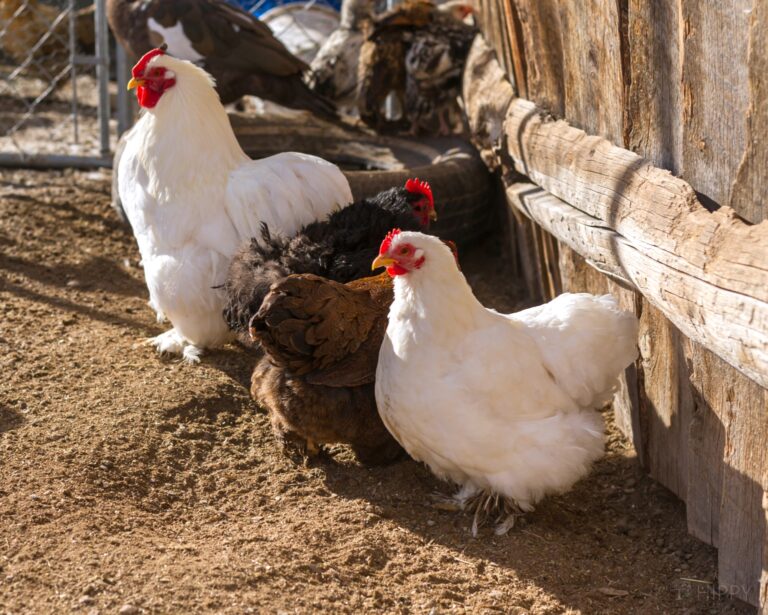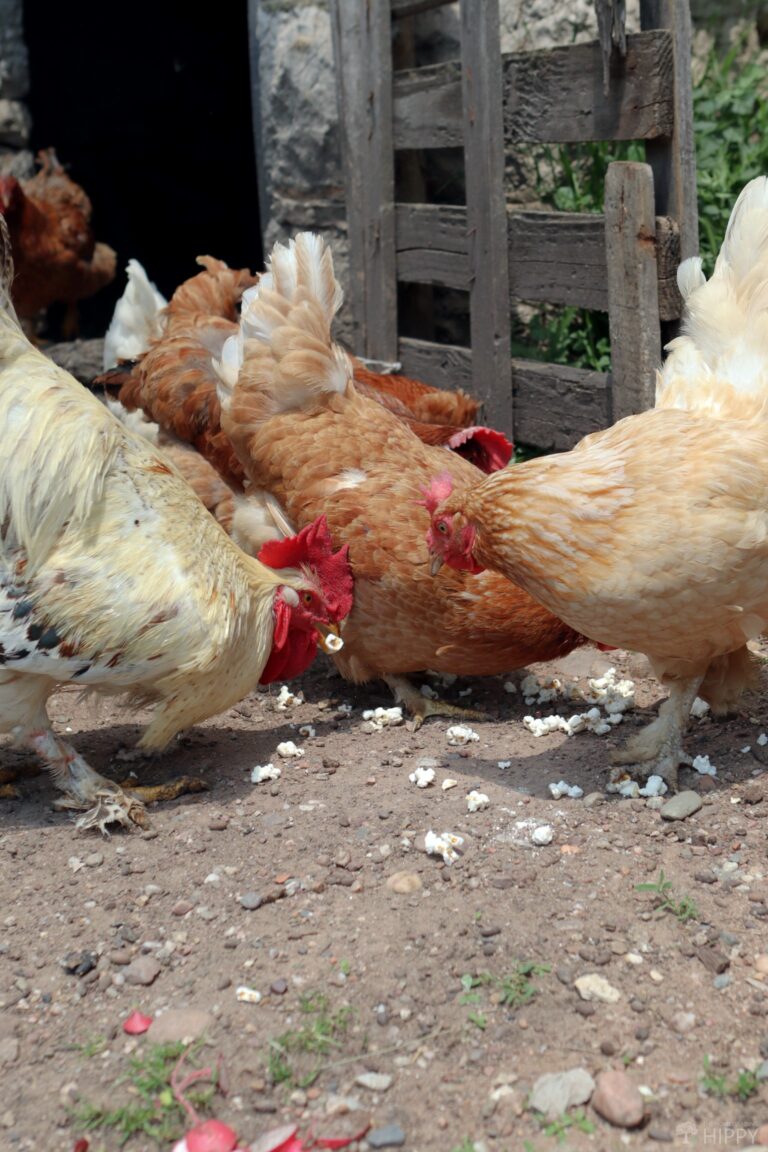Chickens have a reputation as being the smallest of the common poultry species kept around the world, though they are certainly the most numerous. With that being said, even though they are the smallest compared to ducks, geese, and turkeys there is still a considerable amount of variation in how big chickens are…

Excluding exceptional individual birds there are serious differences between breeds, and chickens run the gamut from truly tiny to shockingly tall. So, just how tall are chickens?
An average chicken is about 18 inches tall. On the low end, bantams might stand only 8 inches high whereas giant breeds will commonly stand more than 2 feet tall.
It might not sound like much to worry over for such small animals, but believe it or not the overall height and size of a chicken is actually an important consideration when you are allotting space in the run and coop. And you should also consider that smaller chickens are just a lot easier to work with generally!
Keep reading and I’ll tell you everything you need to know about the height differences in chickens.
Just What is an Average Chicken?
Before we go further, it will be helpful to clarify just what is an “average” chicken. My granddad always said that statistics are a lot like people: twist them enough and you can make them say anything!
An average chicken is better classified as a medium breed. These make up the bulk of domestic chicken breeds on Earth, and include such well-known favorites as Rhode Island Reds and Leghorns.
On average, medium chicken breeds that occupy this category will weigh anywhere from 6 to 8 ½ pounds and stand around 18 to 20 inches tall, though there are considerable outliers in individuals and among different breeds.
But when we compare these medium breeds to other pint-size birds like bantams, such as the Serama, Japanese, and even miniaturized chickens of their own kind, we see they can get quite a bit smaller, anywhere from 8 to 12 inches in height and weighing as little as half a pound.
On the other end of the spectrum, large and true giant breeds stand considerably taller, more than 22 inches as a rule in most cases with some reaching a staggering 30 plus inches in height and tipping the scales at a behemoth 16 pounds.

What’s the Height Range for Standard Chickens?
Standard chickens, which include small (but not bantam) breeds, medium breeds, and large breeds will stand anywhere from 16 to 30+ inches tall.
Again, as detailed above, there is considerable variation in what constitutes the standard category, as distinct from the bantam category below.
What is the Height Range for Bantam Breeds?
Bantam chickens will stand anywhere from a diminutive 8 inches to a comparatively towering 16 inches.
Bantams also show considerable variation in height; this is because some breeds are naturally considered bantams and have always been tiny, whereas others were specially bred to be the way they are or even a miniaturized version of a standard chicken above.
The Japanese Bantam, Booted Bantam, and Sebright are all great examples of true bantam chickens which are naturally quite small.
In the case of developed or miniaturized bantams, the rule of thumb is that they will be anywhere from just ¼ to ⅕ of the size of a standard variety. Still quite small, but rarely as short or tiny as true bantams.
What is the Tallest Known Chicken Breed?
The tallest known domestic chicken breed is the Jersey Giant. Believe me; they live up to their name!
Although they have a reputation for being gentle and peaceful, these mammoth birds tip the scales at an astonishing 16 pounds or even more for roosters, and stand no less than 28 inches tall on average, with 34 inches or even a little bit taller being not uncommon.
Put another way, these phenomenal chickens can stand almost 3 feet tall… That’s the height of many small children! You better have plenty of room if you want a flock composed of nothing but Jersey Giants.
What is the Shortest Chicken Breed?
The shortest known domestic chicken breed is undoubtedly the Serama, which is the tiniest bantam and also the tiniest chicken breed generally. These pipsqueaks on average weigh just a little more than half a pound, around 9 ounces, and on average stand only about 8 or 9 inches tall.
They also happen to be quite friendly and amenable to handling, meaning they make a great pet chicken.
They also happen to be quite beautiful, curious and almost playful, and they’re one of the very best chickens for those who have extremely limited space or small children in the family who might run afoul, pardon the pun, of larger, meaner birds.
Are Hens or Roosters Taller?
Roosters are dependably taller than hens, all other things being equal. Naturally, a rooster from a much smaller breed could still be significantly shorter than a hen from a larger breed.
Otherwise, the boys will typically be taller, heavier and bulkier than the girls, and this is easily noticed even very early on in life.
But, as always, don’t be surprised if you wind up with an uncharacteristically tall and bulky hen one day or a particularly scrawny rooster. These anomalies occur with chickens like every other animal.
Factors Influencing a Chicken’s Height
As already discussed, breed standards are a dependable guideline though exceptional individuals do occur for various reasons.
For instance, if you’re purchasing Leghorn chickens you can count on their average height being anywhere between 21 and 25 inches.
Massive and imposing Malays, on the other hand, will rarely be less than 28 inches tall and seldom grow taller than 32 in. That’s a lot of birds to deal with considering how aggressive they typically are!
Then you also have the genetics of the bird’s parents to consider. Like pretty much every other animal, two large parents will often yield noticeably larger babies, whereas smaller, leaner parents will produce smaller chicks that develop into smaller adults.
This does not always occur, and the intricacies of chicken breeding and genetics are an entire series of articles unto itself, but it is a rule of thumb you can keep in mind.
Another factor is nutrition and overall health. Although every breed will develop a little quicker or a little slower depending on genetics, as a rule, chickens grow into physical maturity quite quickly.
Accordingly, optimal nutrition is imperative if your birds are going to fill out and grow the way they should.
A lack of calories or other essential nutrients could stunt the growth of a chicken and result in a bird that is smaller than it could be. They don’t stay in the growth phase forever…
And lastly, illness plays a similar role in growth as nutrition does. A chick that gets sick, or stays that way, from germs or chronic disease during this critical phase of life will rarely develop to turn out as large as it could be.
That’s another reason why tending to the hygiene and health requirements of young and adolescent chickens is so very important.
How Can You Properly Measure a Chicken’s Height?
If you want to know exactly how tall your chickens are, you need to measure them properly and it’s not as easy as you might think.
First, you need to get the chicken up off of the ground and onto a stable, flat surface. Then, make sure the chicken is standing upright and pay particular attention to its legs: they should not be bent, and the bird should not be squatting, crouching, or stretching upward.
With that done, grab your measuring tape and measure from the bottom of the chicken’s foot to the top of their head, including the comb. That’s it!
If you’re just gathering data on your own flock, this is enough, but if the chicken is going to be shown or entered into a contest, you’ll need to leave it to the professionals who know how to properly position the chicken without influencing the results.
Tim is a farm boy with vast experience on homesteads, and with survival and prepping. He lives a self-reliant lifestyle along with his aging mother in a quiet and very conservative little town in Ohio. He teaches folks about security, prepping and self-sufficiency not just through his witty writing, but also in person.
Find out more about Tim and the rest of the crew here.
